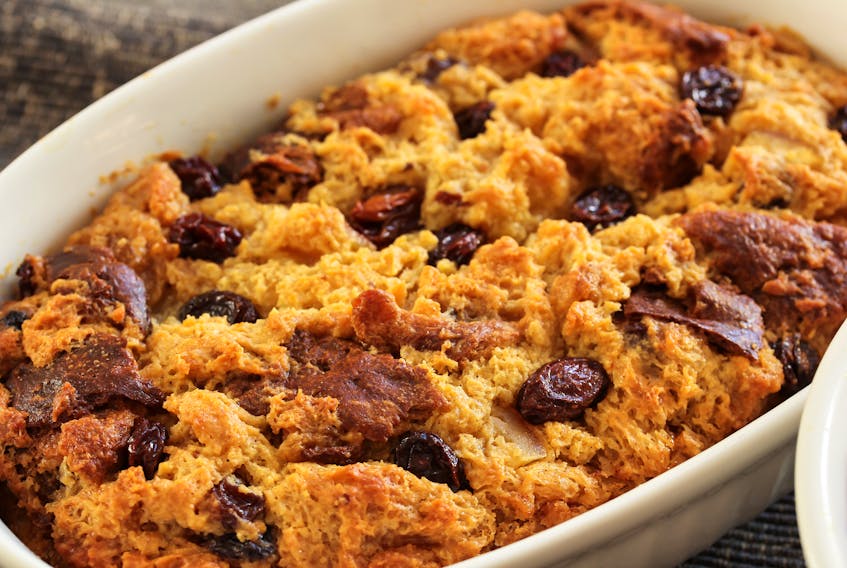
“Pudding” is a broad term. There are savoury puddings and sweet ones, puddings thickened with egg or cornstarch and cooked over simmering water, steamed puddings, boiled puddings, baked puddings.
An egg-rich savoury dish called Yorkshire pudding is a popular part of an English roast beef dinner, but if you’re English, you might use the word pudding as a synonym for dessert.
My Dad’s family, of German ancestry, used to eat blood pudding, a sausage containing blood, fat and meat. There was also one called white pudding, made without the blood. As the only puddings I was familiar with as a child, were sweet desserts, the idea of a pudding with blood in it was not appealing.
Pease pudding, otherwise known as pease porridge – in the pot, 9 days old – is an integral part of a Newfoundland Jiggs Dinner. It’s a savoury pudding, made of split yellow peas tied in a pudding bag and boiled with salt beef for several hours. A pudding bag, made from canvas fabric or multiple layers of cheesecloth confines the contents as they cook in boiling liquid.
For me, the word pudding conjures images of soft sweet desserts usually based on milk and often containing eggs. It includes butterscotch, vanilla (blanc mange) and chocolate puddings, delicious when homemade and now sold in single serving packages for brown bag lunches, as is rice pudding.
What led me to consider the many variations in the pudding category was a request from a friend. He had found suet for sale in a grocery store, and wanted to learn to make a steamed pudding his English mother used to make. Lighter than a plum pudding, it was a plain suet pudding, with Lyle’s Golden Syrup and crystallized ginger. How much more English could it be?
As steamed puddings are not prominent in 21st century cuisine, I turned to several old cookbooks, both published more than 100 years ago, and found that puddings were very popular at the end of the 19th century. The pudding section in The White House Cookbook, by Mrs. F. L. Gillette and Hugo Ziemann, Steward of the White House (The Werner Company, Chicago, 1887) is 56 pages long, and contains such gems as Cream Meringue Pudding, Baked Cornmeal Pudding (versions with and without eggs), Cottage Pudding, several recipes for English Plum Pudding, Queen of Puddings, Nantucket Pudding made with berries and Apple Roley Poley Pudding.
In the quest to recreate the ginger suet pudding, we settled on a recipe for Plain Suet Pudding, which was embellished by lining the pudding mould with syrup and stirring ginger into the batter. He was pleased with the result.
I am a fan of custard-based puddings with additions such as rice, tapioca or bread. Bread Pudding was a great way to use stale bread in days before commercial bakeries started using ingredients to keep their products fresh. It enjoyed a period of popularity on restaurant menus several years ago.
Baking this pudding inside a pan of hot water allows this custard-based pudding to cook evenly, and stay tender. Create your own version by varying the fruit or flavourings, or using a different bread. Serve with cream if desired.
My Grandfather’s Favourite Bread Pudding
adapted from Stewart, Anita: “Anita Stewart’s Canada: the food, the recipes, the stories.” HarperCollins Publishers Ltd., Toronto, 2008.
- 5 or 6 slices stale white bread
- butter
- 3 eggs beaten
- 500 ml (2 cups) homogenized milk
- 5 ml (1 tsp) vanilla extract
- 2 ml (½ tsp) almond extract
- 125 ml (½ cup) packed brown sugar
- 2 ml (½ tsp) cinnamon
- 2 ml (½ tsp) nutmeg
- 125 ml (½ cup) sultana or golden raisins
Trim crust from bread if heavy and thick. Butter bread lightly; tear into 2.5 to 5 cm (one to two-inch) chunks. Set aside.
In a separate bowl, whisk together the eggs, milk and vanilla and almond extracts; stir in the sugar, cinnamon, nutmeg and raisins.
In a 20 cm (eight inch) square glass baking dish, layer the bread and egg mixture. The egg mixture should almost cover the bread. Place baking dish in a larger pan containing 2.5 cm (one inch) of very hot water. Bake, uncovered, in a 160 C (325 F) oven for one hour or until the top is golden and the custard is set.
4-6 servings
Margaret Prouse, a home economist, can be reached by email at [email protected].









